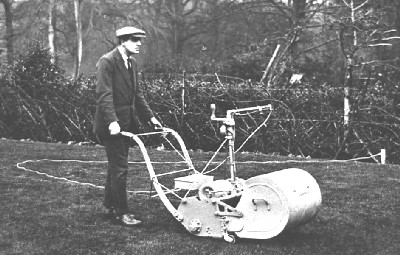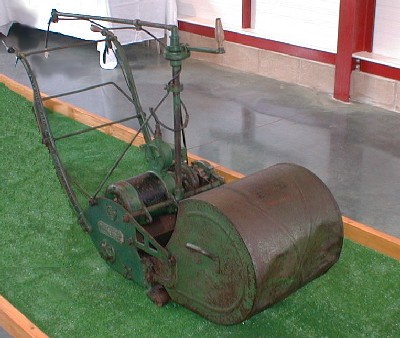MP040: Ransomes Electra

When the Ransomes Electra was introduced in 1926 it was the UK's first commercially available electric powered mower. Other companies had tested electric powered mowers before this, and at least one manufacturer in the US began production of electric powered machines at around the same time, but the Electra was the first to be sold successfully in the UK.
The Electra was powered by an electric motor fed from mains electricity. Although mains power had been available for some time in the UK it was largely confined to urban areas where there was a ready market. Supply in rural areas was patchy at best although some larger houses were occasionally connected and a few even had their own power generating plants.
The limited availability of main electricity would not have helped sales of machinery like the Electra although there were some compelling reasons why this would emerge as a useful way of powering lawn mowers. Pound for pound electric motors are more efficient than petrol engines, especially at the relatively small outputs required for powering lawn mowers. Electric motors offer instant power and, assuming a supply is available, never run out of fuel. They are also quieter, less smelly and cleaner than petrol engines.
Nevertheless electric power presented new problems that designers had to overcome. One of the most obvious of these was that the mower was constantly connected to the mains by a long cable. This meant that the mower could only be used where the cable would reach! Another limitation was the constant risk that the mower would run over and cut through its cable to leave potentially dangerous bare live wires. This was in the days before contact breakers and other safety devices so care had to be taken. The solution devised by Ransomes was to hold the cable above and away from the main body of the mower with a swinging arm. This helped reduce the risk of snagging the cable when the mower was in use or of running over and cutting it.
Ransomes already had great experience with electric powered machinery, especially tram cars and trolley buses which the company continued to make for some years after its first electric mower. In some respects the arm on the mower resembles the devices used by trams and trolley buses to connect to the overhead cabling above the streets!
The Electra was initially available in 16" and 20" cutting widths. These were followed by a 14" model and, later still, 24" and 30" designs. The larger models were based on existing Ransomes motor mowers but the 14" was in electric powered version of the Countess, one of its popular hand operated models of the same period. In some of the company's contemporary publicity material the mower was designated as the Countess Electric Lawn Mower but the Electra name was adopted for the entire range soon after.

The Electra remained in production throughout the 1930s although it was superseded in 1936 by new Ransomes Lawnic and Bowlic designs. After this sales of the Electra appear to have been mainly in the export market. Although it did not sell in great numbers it was nevertheless a useful addition to the Ransomes range that offered an alternative power source or in situations where quiet operation was desirable. It is also, as the first production model electric mower, an important stage in the development of the lawn mower especially as so many modern domestic machines are electric powered.
By the 1950s electricity was much more widely available, especially in rural areas and "ordinary" houses. This led to the introduction of many different electric mowers from the leading manufacturers. These were often based on the equivalent hand machine from the company.
A number of Ransomes Electra mowers have survived, mainly in museums, although one or two are also in private collections.
